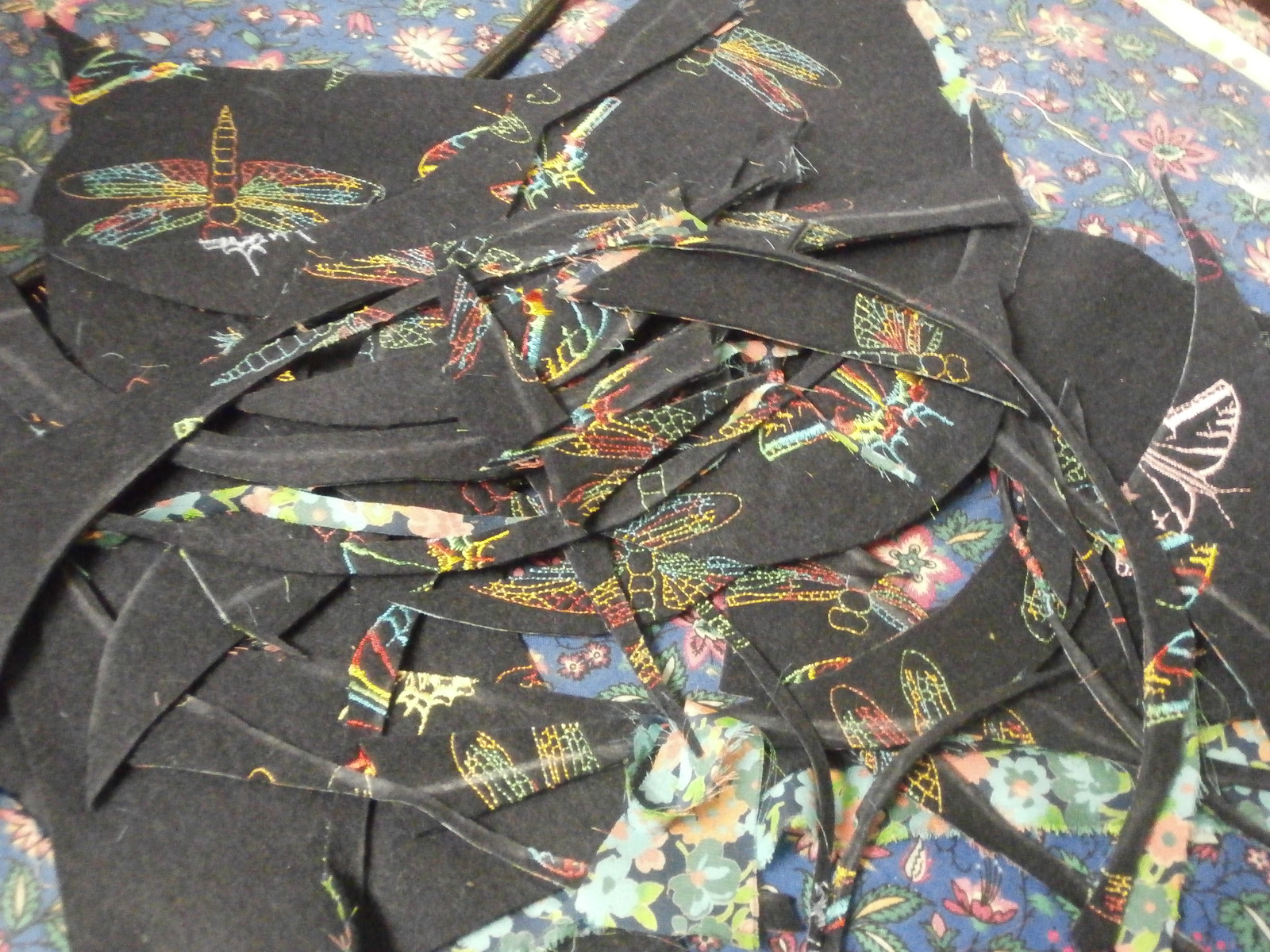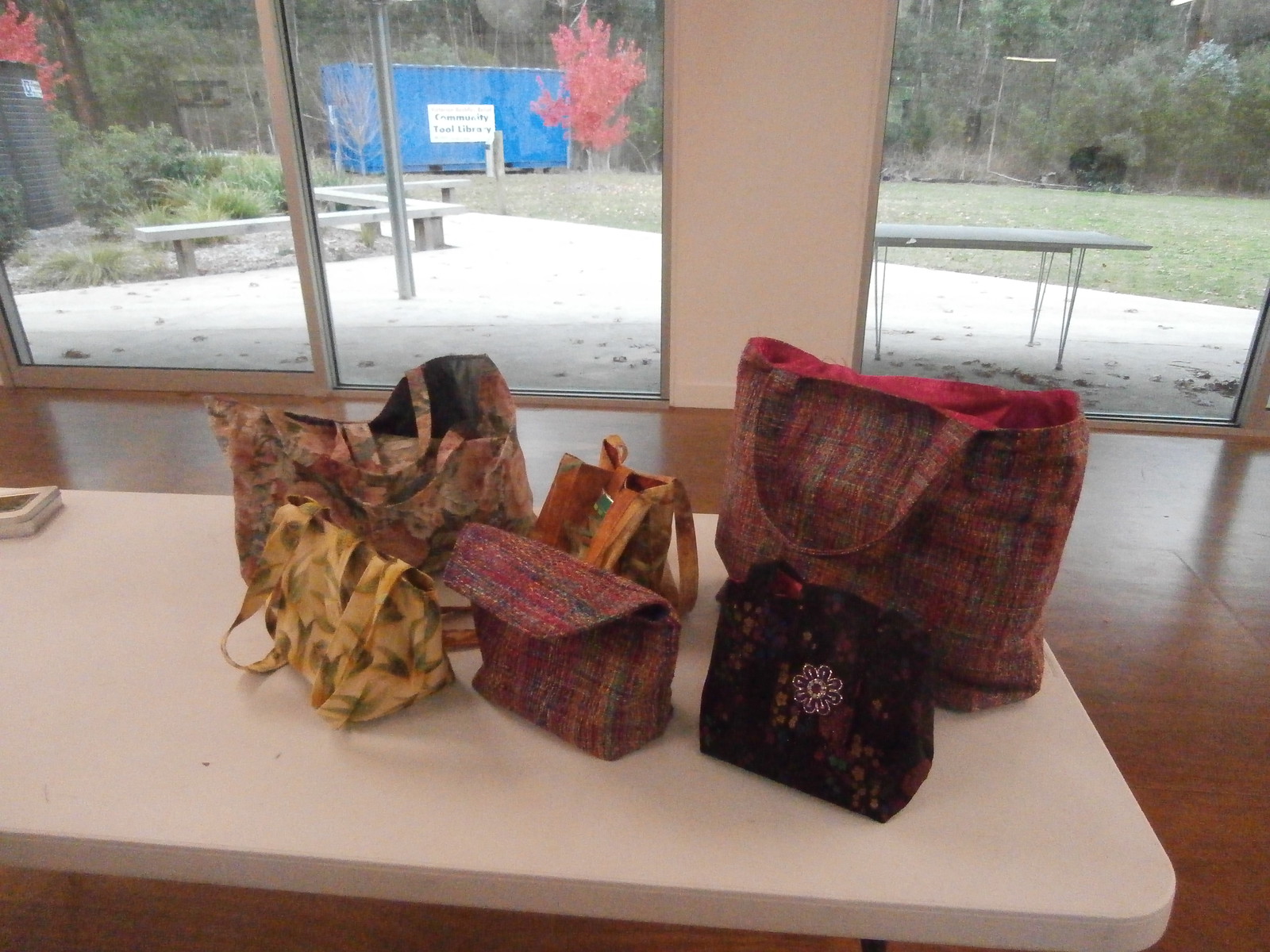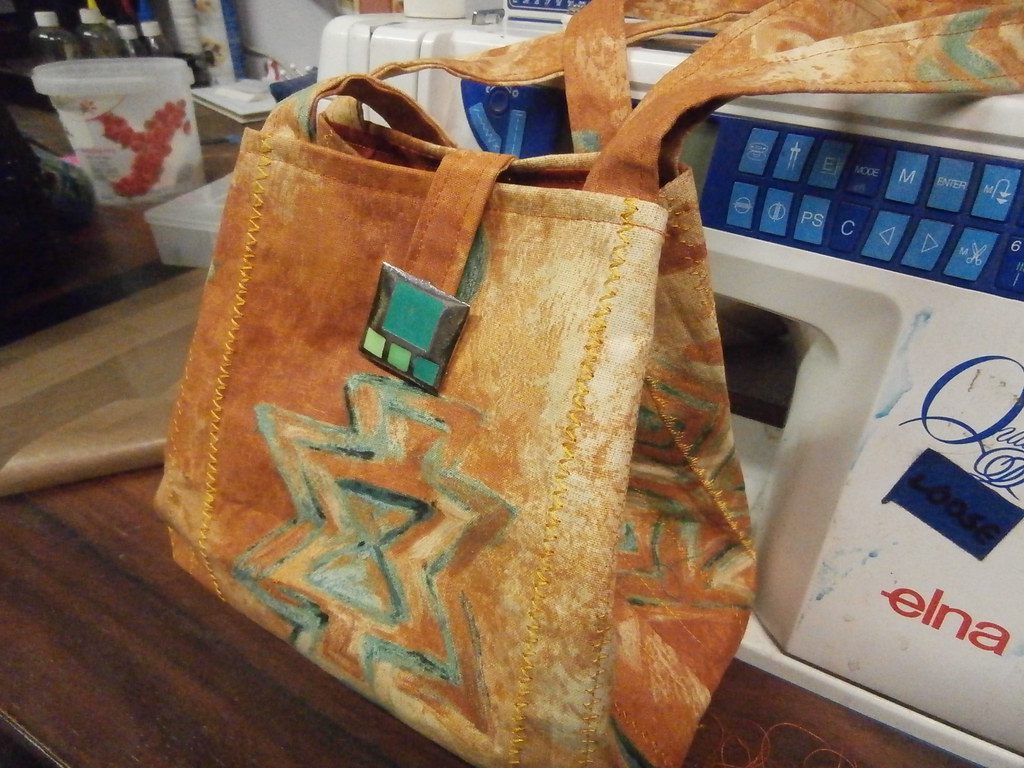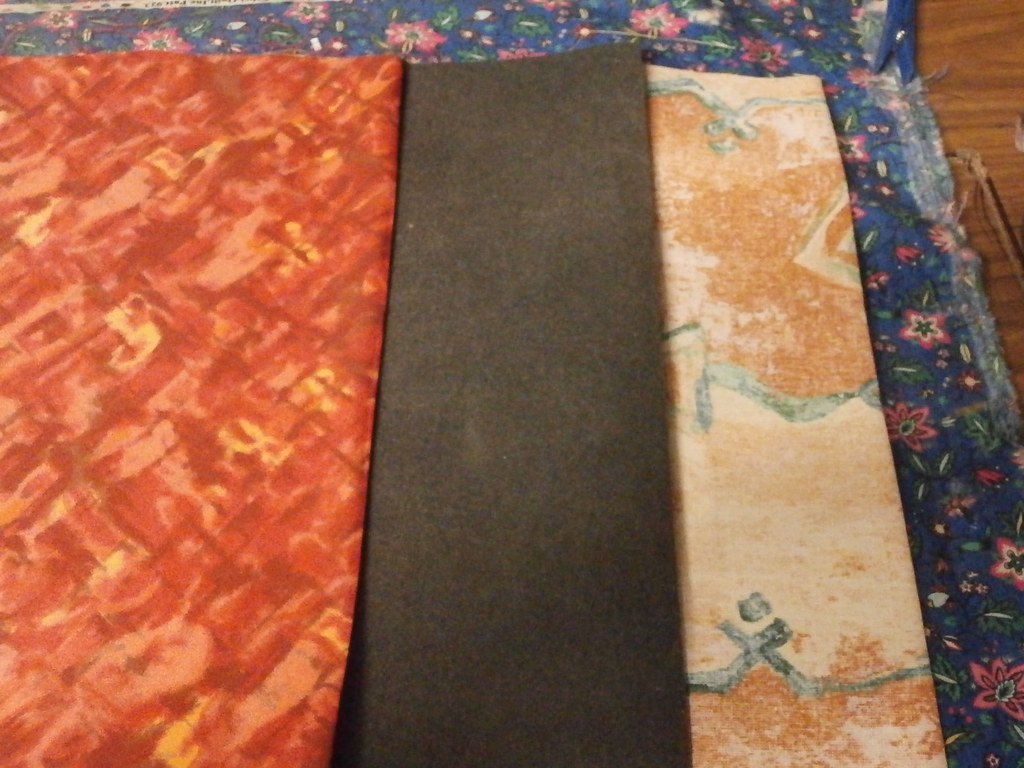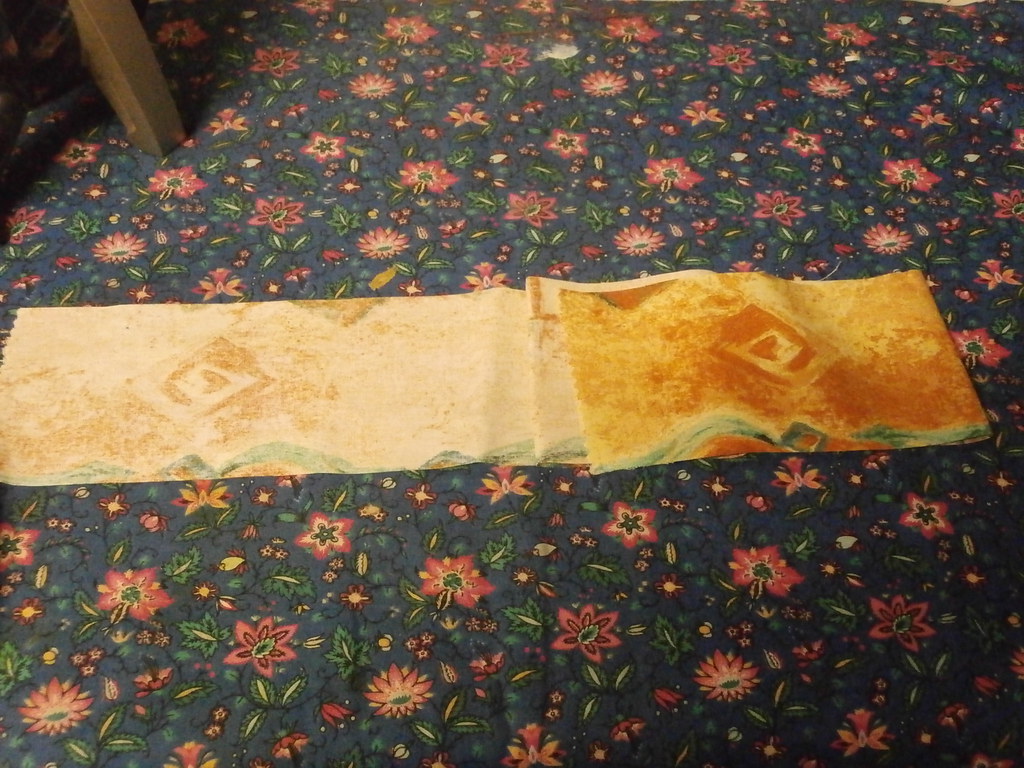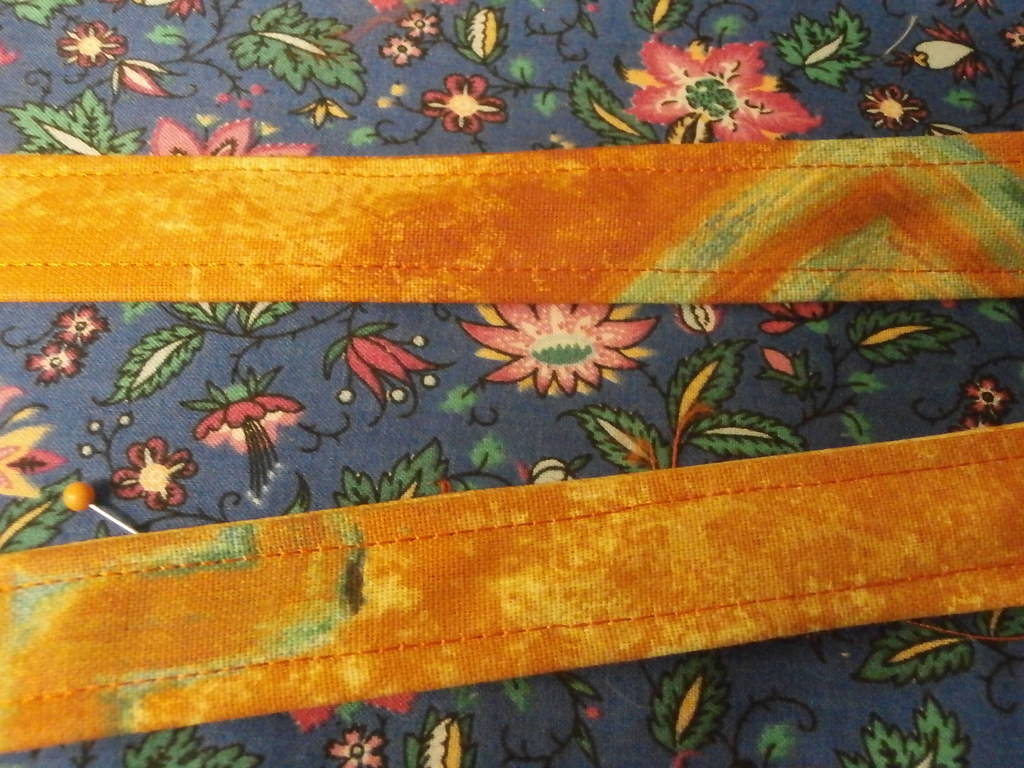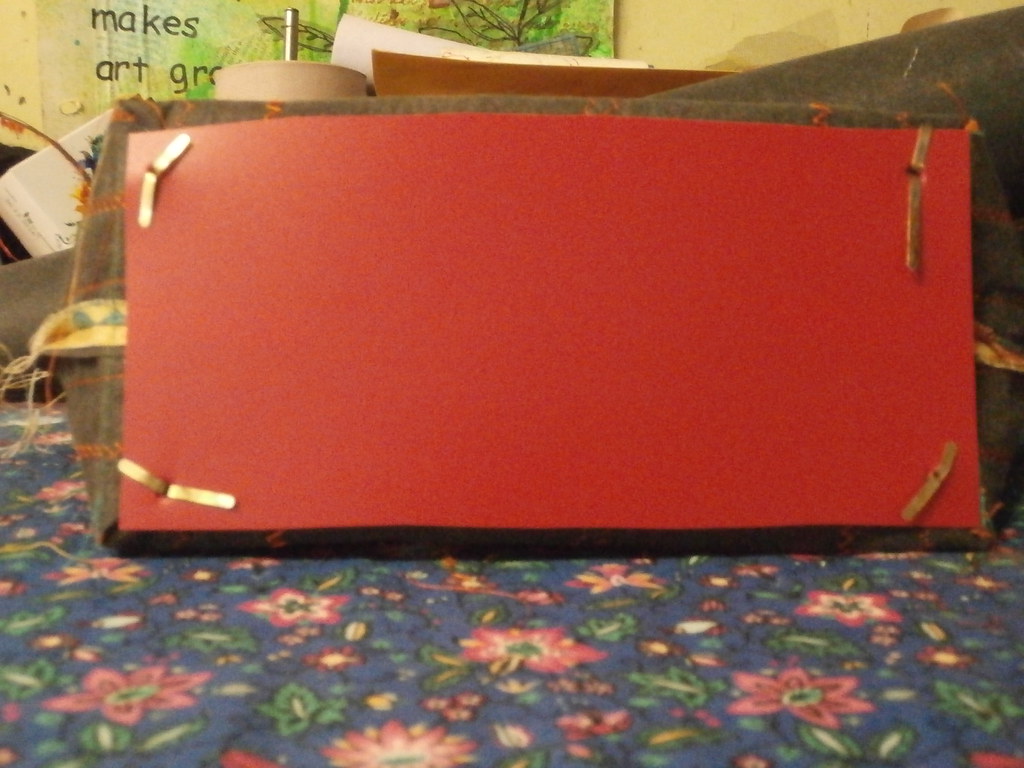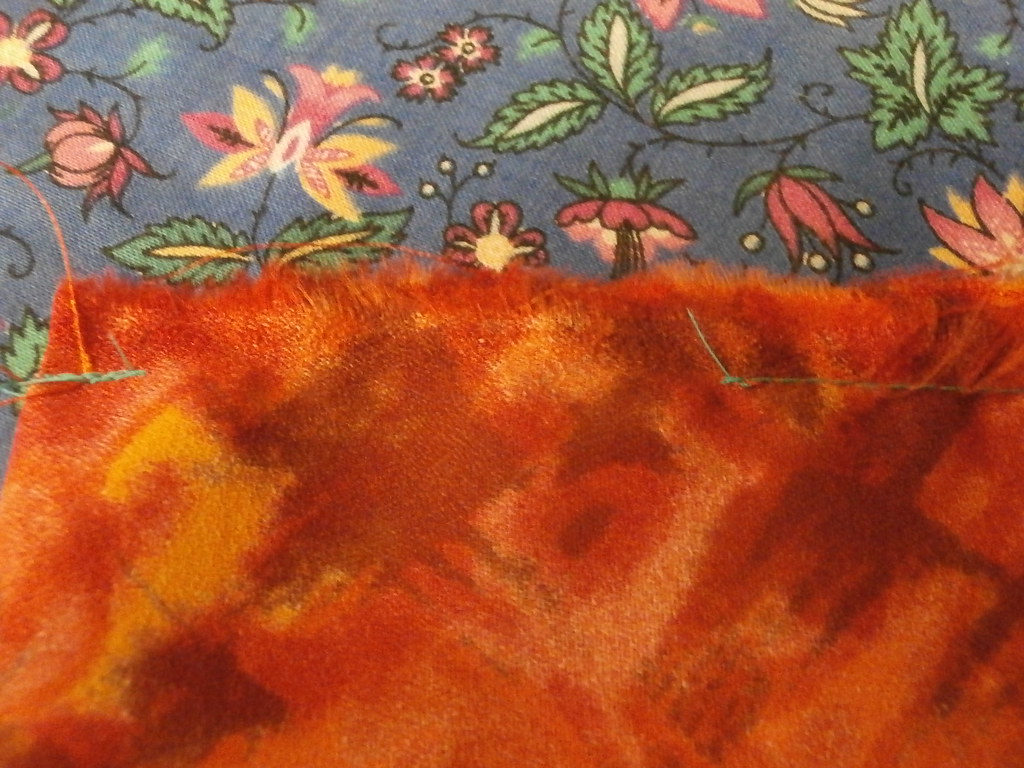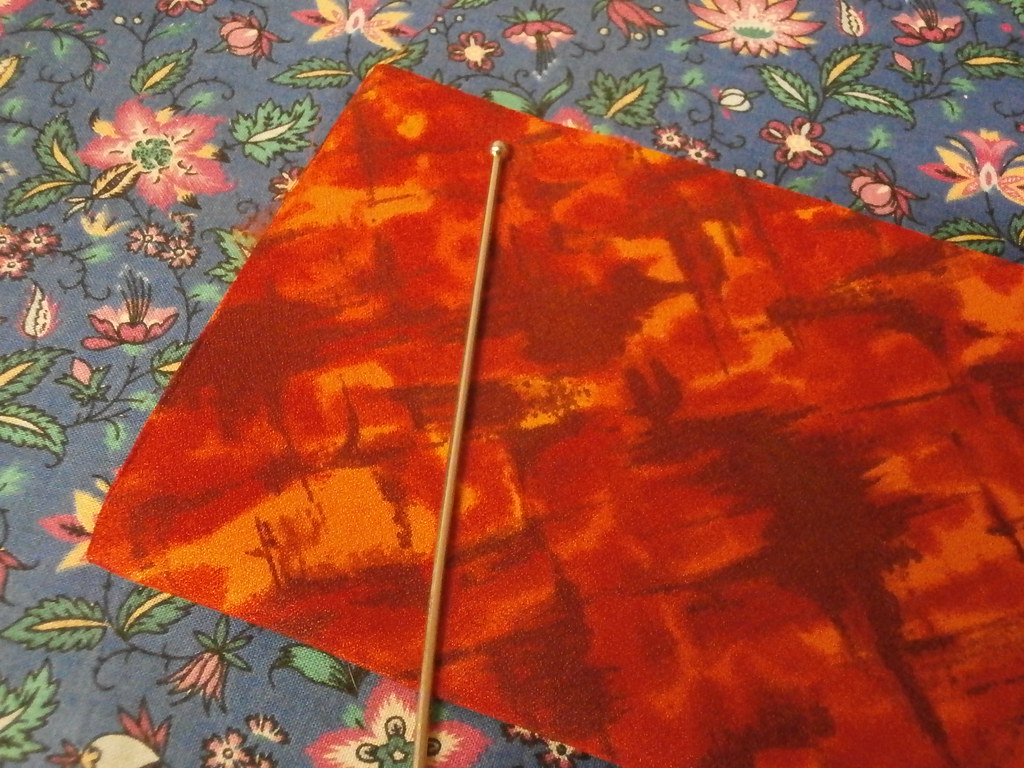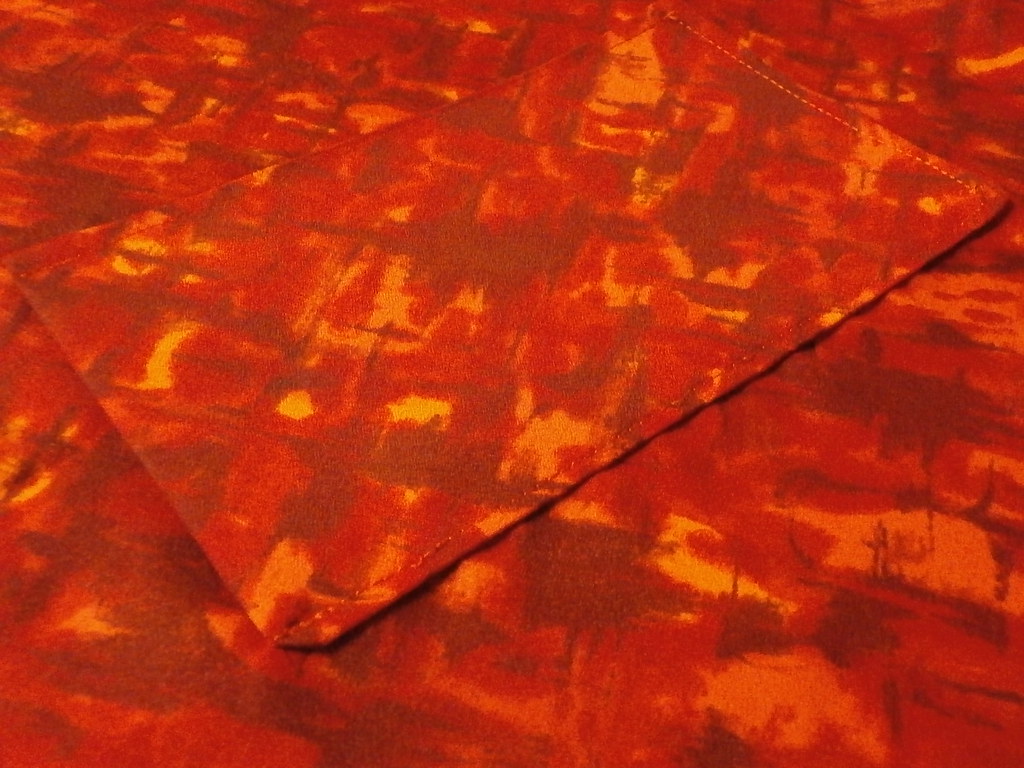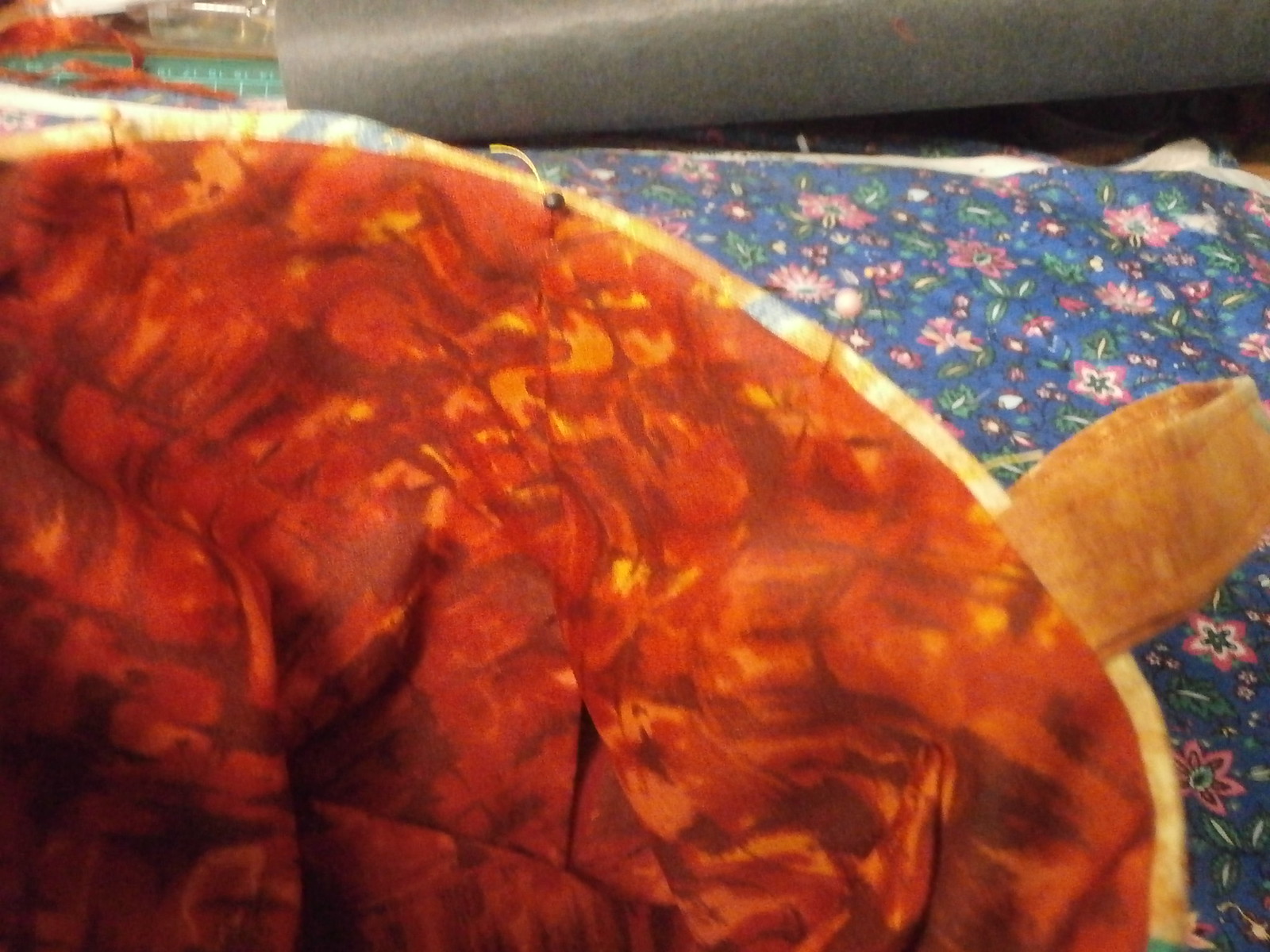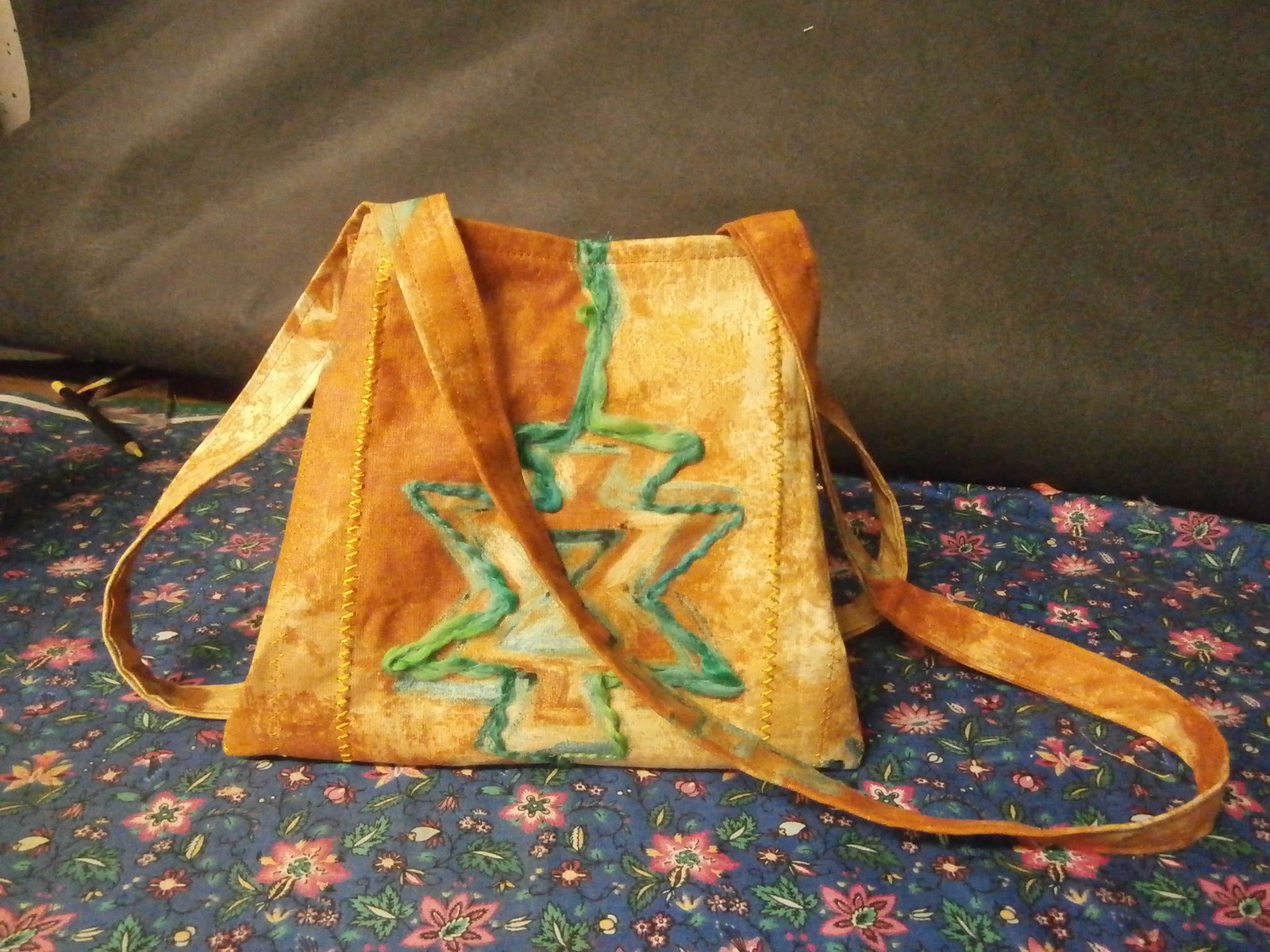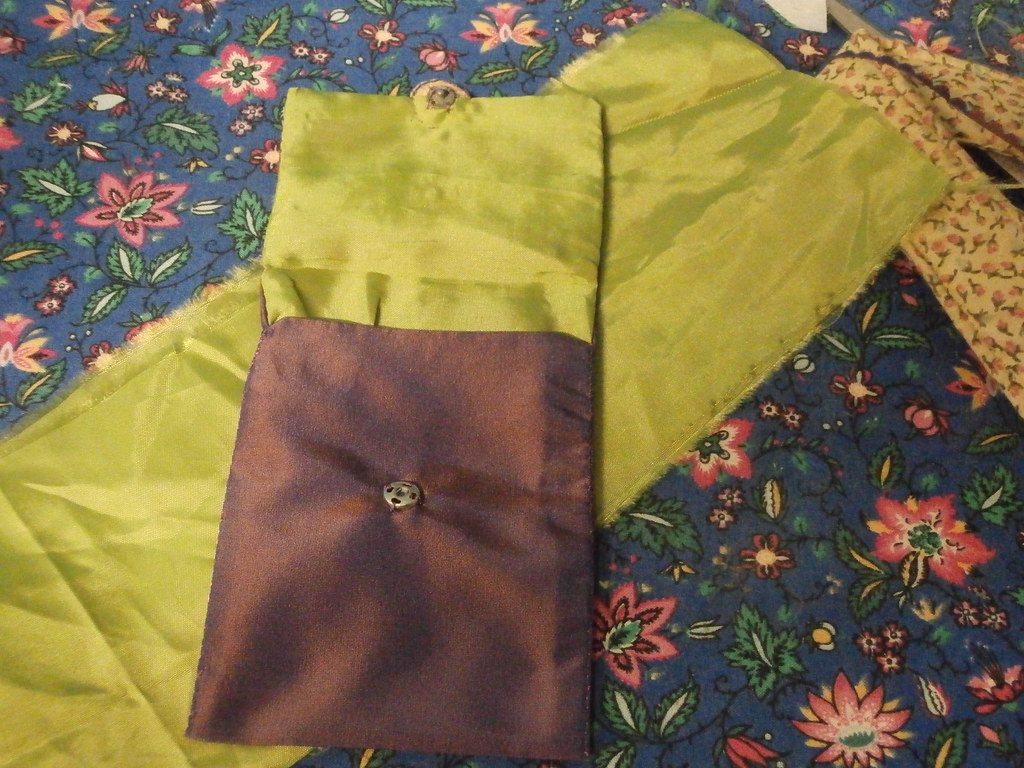I do try to blog most days, but this week has been a turbulent one in our household and the internet has been a bit iffy, so sorry for that.
Today's post is just a bit of miscellany from my studio.
Firstly, remember that felt I was embroidering all over with the embroidery machine?
Well, I finished it. And then.....
I cut it all up! If you remember, I said I was going to make a bag. Well, it is all cut into the pattern pieces for the bag, and I will show it to you when it's done, since it is not my design.
And here is a collage page I did in one of my journals. The butterfly is 3D. It contains painted papers, some of the stickers I made the other day, gelli prints and bits and pieces from my collage box. I was very pleased with how it came out, since I just started sticking whatever was to hand.
On another note, recently, I watched a Mary Beth Shaw webinar and she mentioned that she often uses water based matte house paint as a bottom layer in her journals, so I thought I would try it out as we have a ton of it.
Even though this says white, it was actually egg shell blue
This was my first sample page, where I tried out different media on it. Clockwise, from top left, watercolour from my palette, inktense blocks, watercolour pencils, a black paint marker, A yellow waterbased marker, a red faber castell marker, a gel pen, pink acrylic in a dabber bottle, acrylic with a make up sponge, and lastly acrylic with a brush.
They all did rather well on it I must say, and it dries very fast, leaving a great matte surface. So, another thing to recycle that would otherwise have to be disposed of. It covers better than gesso and is more matte!
So, i now have a lot of pages already painted and dried, going through the final test, which is whether the pages will stick together. However, if they do, I will just give them a light sand, which is what I do with painted pages when they stick.
So that is my mixed bag for today!
Happy Creating!
Showing posts with label bags. Show all posts
Showing posts with label bags. Show all posts
Thursday, May 29, 2014
Monday, May 19, 2014
The workshop
oops, I meant to post this yesterday and forgot.
The bag workshop went really well
I only had five students, as a few no showers, but that was plenty, really
Here they are, all hard at work. They all did quite different things. And here are their results
Not all quite finished, but looking pretty good!
They were all quite happy with their creations, and so they should!
Happy creating!
The bag workshop went really well
I only had five students, as a few no showers, but that was plenty, really
Here they are, all hard at work. They all did quite different things. And here are their results
Not all quite finished, but looking pretty good!
They were all quite happy with their creations, and so they should!
Happy creating!
Labels:
bags,
fiber art,
fibre art,
mixed media,
textile art,
workshop
Friday, May 16, 2014
A simple bag
A few months ago, I posted about a little bag I made and intended to post a tutorial. Well, months later, tomorrow I am teaching a workshop on it and have been writing notes, so here is the tutorial.
Main Bag fabrics
Decide on the size bag you want
Basically, the base size for my bag is 25 (height) x 16 (width) inches. This is a good size to start and as you get experienced at the technique, you can change it to suit.
If you want a taller bag, add to the height, conversely if you want a wider bag, add to the width. Getting your shape and size will come with practice and, you can also change the proportions slightly during the shaping process
In the picture above, there are three pieces which are cut to the size you have decided on.
Easy Bag construction
Main Bag fabrics
Decide on the size bag you want
Basically, the base size for my bag is 25 (height) x 16 (width) inches. This is a good size to start and as you get experienced at the technique, you can change it to suit.
If you want a taller bag, add to the height, conversely if you want a wider bag, add to the width. Getting your shape and size will come with practice and, you can also change the proportions slightly during the shaping process
In the picture above, there are three pieces which are cut to the size you have decided on.
- A lining. I use a light fabric like satin, but for easier handling, a simple cotton will work. It is sometimes a problem to use black, simply because, you might find it hard to find things in your bag later. This is a personal preference.
- Interfacing. I generally use a heavy interfacing for most fabrics, as it gives a sturdier result.
- Outer fabric is a personal choice. Choose what you like, as it will be with you for a while!
Some other alternatives are to use quilted or embroidered fabric, which might not want any stabilizer.
Handle construction
The handle lengths are dependent upon the wearer, but for a long handle, about 32 inches is standard. For short handles 8 to ten inches is suitable, but you can change it to suit yourself.
Following steps 1 to 4 above
- Cut two 4 inch wide strips of your chosen length. If you wish to use interfacing or batting to made them thicker, cut 1 inch wide strips of the same length (not shown)
- Fold and press the strips in half and open out. If you are adding batting or interfacing, add it at this stage and place to one side of the centre fold.
- Fold each side of the strip into the centre and press. Use pins if you need to.
- Finally fold in half so the raw edges are in the middle.
Depending on your bag, you can either topstitch each edge of the handle, or use decorative stitches to match the bag.
Constructing and shaping the outer bag
The fabric needs to be attached to the interfacing to create a quite sturdy fabric. This can be done using some decorative stitching, foundation or crazy piecing (if you are using several fabrics) oreven hand stitching and/or beading (however with hand work, keep the stitching an inch or so from the edge so that the threads are not cut during trimming)
You can fuse the fabric to the facing, but the fusing will come away with time and use, so for a sturdier bag, all over stitching is advised.
Once you have the hang of the method, you will be able to stitch up 'blanks' or rectangles of fabric and interfacing using any technique you like to make bags from (I will post separately about this)
Fold the main outer bag piece in half along the width. Sew a 1/2 inch seam along each side.
Turn the piece inside out and fold the bottom of the side seam back against the base of the bag See first photo, above. You can see that the seam splits the triangle formed in half. I use a triangle template to mark the stitching line.
Stitch along the line, reinforcing at the start and end for stability and repeat on the other side.
When the bag is turned right side out, it will stand up easily on it's new base.
You can trim the triangles, but leaving them in gives the base more heft.
Support the base of the bag (optional)
To add support to the base. Cut a piece of thin plastic (I use plastic covers from plastic pocket books) the same size as the base of the bag.
The easiest way to attach the bag is with some glue on the folded in triangles inside the bag, but I like to use large brads to make little feet to protect the base fabric. I make small holes in the plastic and the base fabric and push the brad legs through, opening the legs on the top of the plastic inside the bag. You can add a little bit of tape over the legs, to stop them wearing on the lining if you want.
You can also sew buttons through the base and the plastic in the same way.
Construct the lining
This is exactly the same as the main bag construction (leaving an opening for later)
- Sew up the edges of the lining (right sides together)
- Leave an opening on one side for turning the bag out later
Construct duck bills for the base in the same way as for the outer bag.
Construct a pocket
Decide on the size pocket you want. Cut a piece of fabric twice as large or two pieces of the size, both need to have seam allowance added.
With the pocket pieces right sides facing, stitch together around the perimeter, leaving a 2-3 inch opening
Reinforce the beginning and end of the stitching around the opening by backstitching.
Turn the pocket out and use a turning tool if you wish, to push the seams and corners out. Press and press the opening in at the same time. You will catch it down when you stitch it in place.
Sew the pocket to the inside/right side of your lining piece. Work out the placement using the lining and outer as a model.
Constructing a tab or flap
You may wish to add a tab or flap to the top of your bag. Decide on a size or shape you like
Or, you could construct a flap, which folds over most of the top of the bag.
The tab or flap is constructed in the same way as the pocket, however, the top seam is not stitched (see above) and this is where you turn it out. If you are stitching a decorative element onto the tab or flap, stitching it on before doing the seams and turning will hide the back of your stitching.
Putting the bag together
At this stage, you will need
- The outer bag, inside out
- the lining, right side out
- the tab or flap
- handles
First, pin the handles to the inside of the main bag, with the loops inside. Do the same with the tab or flap.
Then place the lining inside and line it up with the raw edge of the main bag.
Pin, replacing the tab and handle pins as you go.
Stitch the top seam, reinforcing the handles and tab by backstitching.
You can now pull the lining out of the bag and turn the whole thing inside out using the opening in the lining you left earlier.
Once you have turned the bag right side out, push the lining back into the bag
Press the top seam and topstitch.
Add press studs to the tab or flap and the front of the bag
To make the bag cinched at the top
Work out how much you want the bag to cinch, by folding the top seam at the sides until you like how it looks. Mark where you need to add the press studs to hold it in place.
The press studs will go on the sides of the bag at the top.
Enjoy your bag!
This has been an overly long post! I will try and remember to take pictures of student work tomorrow to share with you.
Happy Creating!
Labels:
bag,
bags,
fiber art,
fibre art,
mixed media,
textile art,
workshop
Sunday, May 4, 2014
Using my new toy
I have been playing and learning and making samples with my new embroidery machine, but I thought it was time to make something!
Last night I put together the first steps of a bag for the workshop I am teaching in a few weeks.
I have quite a number of satin samples that are 4.5 x 12 inches. You can see them in the layout above.
I embroidered a celtic knot on one of them and basically used the size of the pieces as the bag pattern. The picture above is before I sewed them on to a piece of interfacing cut to the size above.
This picture is bit closer to the real colours. I have sewed the strips onto the stabiliser and peeping out from the bottom, you can see the lining cut to the same size.
This is as far as I got, since I was thinking about the handles.
This morning, I embroidered another and made a quick little ipod or phone case.
My favourite colours again! I did not line this one with interfacing, so it is very soft.
This photo shows the construction (including a little boo boo!) All i did was to sew the lining and cover right sides together, leaving a few inches unsewed, then turned it inside out. I folded it to fit my ipod and hand sewed the sides up, and added press studs and a little embellishment to cover the press stud.
Voila!
I am thinking of lots of new ideas to use this new tool, but my fingers are itching to do some free motion, so hopefully I will get some done in the next few days.
Happy Creating!
Last night I put together the first steps of a bag for the workshop I am teaching in a few weeks.
I have quite a number of satin samples that are 4.5 x 12 inches. You can see them in the layout above.
I embroidered a celtic knot on one of them and basically used the size of the pieces as the bag pattern. The picture above is before I sewed them on to a piece of interfacing cut to the size above.
This picture is bit closer to the real colours. I have sewed the strips onto the stabiliser and peeping out from the bottom, you can see the lining cut to the same size.
This is as far as I got, since I was thinking about the handles.
This morning, I embroidered another and made a quick little ipod or phone case.
My favourite colours again! I did not line this one with interfacing, so it is very soft.
This photo shows the construction (including a little boo boo!) All i did was to sew the lining and cover right sides together, leaving a few inches unsewed, then turned it inside out. I folded it to fit my ipod and hand sewed the sides up, and added press studs and a little embellishment to cover the press stud.
Voila!
I am thinking of lots of new ideas to use this new tool, but my fingers are itching to do some free motion, so hopefully I will get some done in the next few days.
Happy Creating!
Monday, January 21, 2013
Languishing
So I am back. I have had a bit of a break from my textile work, doing things that I never have time for, which is lucky, because it is very hot here and when it is hot I am not at my best.
I made some little bags for the ladies in my family for christmas
I made six of these in different colours, from recycled fabric and braids, The inspiration was a felt bag in quilting arts episode 1010, by Rebecca Kemp Brent, which used the sole plate of an iron for a pattern! However, I made lined bags and did not embellish the panels.
I spent a lot of time with my puppy, Ruby, who is growing up fast, but has not stopped chewing everything as you can see from the arm of the chair she is sitting on, lol
I made a few pieces of jewellery.
I made some free motion butterfly wings on organza
and some more
I have been working on a quilt as part of a Craftsy Course - Beyond Basic Machine Quilting.
I have altered my piece slightly, I did reverse applique with painted organza for the feather flowers and I used satin as my foundation. It made it slightly more difficult but I like it. As you can see at the moment, I am slowly filling in the background.
I have also been doing stupendous stitching and stitch and slash with Carol Ann Waugh at craftsy, but nothing to show there yet.
I have been working on my Blue Piece for Tangled Textiles, which is due in a week. Above are some of my blue bits and pieces - just a peek. I am not happy with how it is going, and wish I had stuck to my first idea, but of course there is no time to change now.
I have also been reading a lot - something I hardly ever do (stories, that is, I read text books a lot). I started reading Robert Jordan's "wheel of time" series twenty years ago and the final book was released earlier this year and I got it on my birthday, but I decided that I needed to reread all of the books from the beginning so that it is all fresh in my mind when I start the last one. There are 14 books altogether and none of them is short, hardly any less than 500 pages and most are more, so that is going to take me a while - lol.
I have been finding it hard to get back to work, but hopefully getting back to blogging will help put a bit of discipline into my days!
Be creative every day
I made some little bags for the ladies in my family for christmas
I made six of these in different colours, from recycled fabric and braids, The inspiration was a felt bag in quilting arts episode 1010, by Rebecca Kemp Brent, which used the sole plate of an iron for a pattern! However, I made lined bags and did not embellish the panels.
I spent a lot of time with my puppy, Ruby, who is growing up fast, but has not stopped chewing everything as you can see from the arm of the chair she is sitting on, lol
I made a few pieces of jewellery.
I made some free motion butterfly wings on organza
and some more
and some dragonfly wings.
I have altered my piece slightly, I did reverse applique with painted organza for the feather flowers and I used satin as my foundation. It made it slightly more difficult but I like it. As you can see at the moment, I am slowly filling in the background.
I have also been doing stupendous stitching and stitch and slash with Carol Ann Waugh at craftsy, but nothing to show there yet.
I have been working on my Blue Piece for Tangled Textiles, which is due in a week. Above are some of my blue bits and pieces - just a peek. I am not happy with how it is going, and wish I had stuck to my first idea, but of course there is no time to change now.
I have also been reading a lot - something I hardly ever do (stories, that is, I read text books a lot). I started reading Robert Jordan's "wheel of time" series twenty years ago and the final book was released earlier this year and I got it on my birthday, but I decided that I needed to reread all of the books from the beginning so that it is all fresh in my mind when I start the last one. There are 14 books altogether and none of them is short, hardly any less than 500 pages and most are more, so that is going to take me a while - lol.
I have been finding it hard to get back to work, but hopefully getting back to blogging will help put a bit of discipline into my days!
Be creative every day
Subscribe to:
Posts (Atom)


